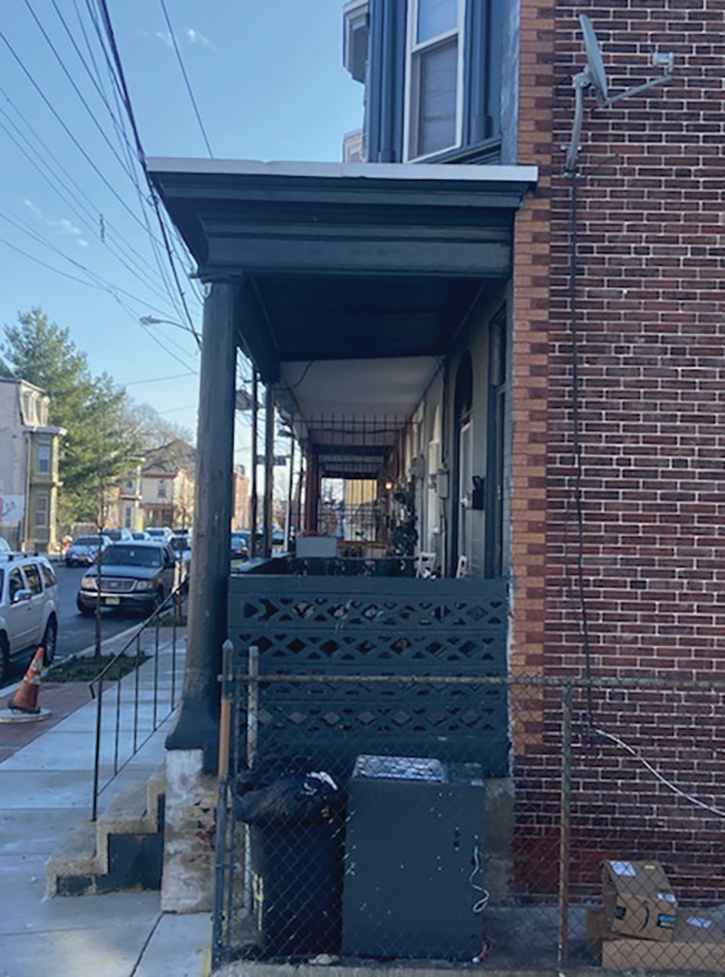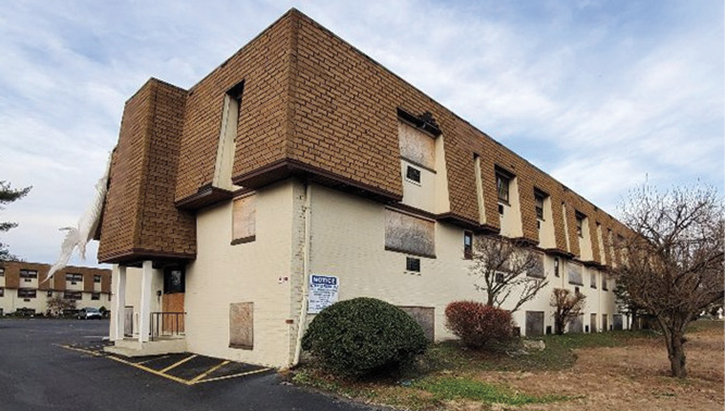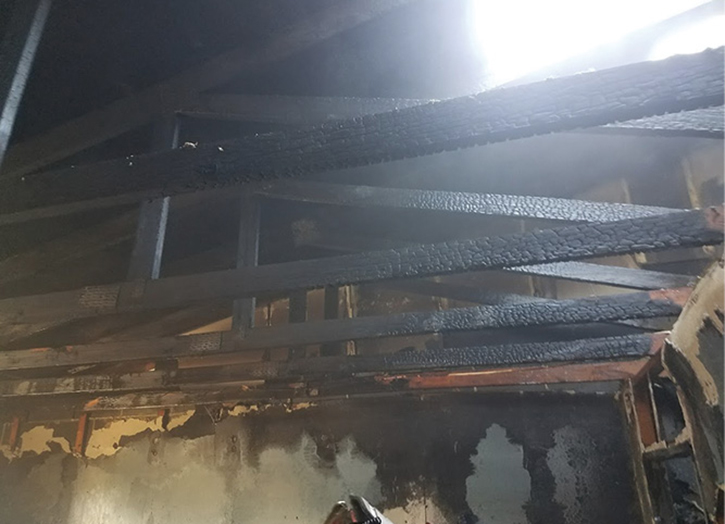TRAINING NOTEBOOK ❘ By DANNY STRATTON
A “continuous” structure is defined in this article as a series of three or more occupancies that are attached and share a common wall between the separate properties. These buildings can be residential such as garden apartments or commercial strips. Legacy construction labels them as “row homes” or “taxpayers.” In modern terminology they are “townhouses” or “strip malls.” Usage can be mixed with residential or commercial occupancies.
The presence of structures adjoined in a continuous arrangement presents challenges regarding the spread of a fire’s by-products of combustion, especially under wind-driven conditions. The horizontal spread of heat, smoke, and fire can be the main concern when combating this type of incident. A fire department must ensure it employs proper tactics and sufficient and timely resources on scene to cease the forward progress of fire and smoke.
Legacy Continuous Structure
With a legacy continuous structure, the major concern is fire and smoke traveling horizontally through a cockloft. If these lofts are not draft stopping by-products of combustion, fire will rapidly consume a row of occupancies.
In old communities, “party walls” are common in separating different properties. A party wall is not a true fire wall. However, it does have some fire protection tendencies. The earlier intention was to stop fire and enhance soundproofing between units. In older ordinary construction, rows built with brick were used in its assembly. Brick serves as a good way of ceasing fire and heat. The tops of these walls terminate one to three feet above the roof line. On the downside, the by-products of combustion can spread through their joist pockets, where both properties’ floor and roof rafters meet. Sooner or later, this feature can spread smoke and fire to the attached unit.
To mitigate such a situation, additional companies must check for extension and be ready to deploy hoselines, firefighters with pike poles prepared to open ceilings, and proper staffing to open the roof to stop lateral fire spread. The presence of a common cockloft should alert the incident commander to consider going down several occupancies to cut off the spread.
Using a thermal imaging camera (TIC) on the roof may identify the lateral position of the fire, which can help determine where to make a stand and prevent the fire from overrunning a defensive position. The TIC can work at ground level by panning the exterior walls if the walls are heated enough and aren’t comprised of masonry or brick. Caution: Don’t rely solely on the TIC on the roof; if the decking has insulation or several layers of new roofing material, a heat signature may not appear. Inspection holes on the roof and below may be your only option to determine location and extent.
Modern Continuous Structure
In modern constructed lightweight wooden rows, the presence of a truss loft under floors and roofs with no draft stopping is a major construction issue. These lofts are the most dangerous horizontal voids that exist, especially if they support a floor. The use of lightweight wood trusses allows easy fire spread compared with its predecessor, legacy solid wood joists. The “open” nature of the wood truss allows fire to spread quickly over its large surface area, rapidly consuming the truss. Of course, dead and live loads imposed on the floor truss can precipitate collapse.
The protection against lateral spread in structures means having draft stopping in place. Draft stopping slows the spread of fire laterally inside a horizontal void. If a structure does not have such a measure, fire will quickly consume the entire building (photo 1).

(1) ) New construction with a truss loft will allow quick fire spread compared with older legacy lumber. Note the plywood serving as a draft stop to slow flame advancement to the attached unit. (Photos by author unless otherwise noted.)
Continuous Porches
The presence of “continuous” porches that are connected between properties can provide an avenue to lateral fire spread. The underside of this structure feature can transfer fire from unit to unit, especially if the wind is strong (photos 2, 3).


(2, 3) Row homes with attached porches can challenge firefighters attempting to stem horizontal spread to adjoining properties. (Photos by Bobby Eckert.)
If a hoseline is unavailable, a simple measure to terminate this problem is to use a water or other class A extinguisher. This phenomenon, called “flame over,” can be defeated easily with one of these extinguishers.
Mansard Soffits
The presence of soffits can contribute to the lateral transfer of the by-products of combustion to an adjoining structure. The mansard soffit is a façade attached to the exterior wall of a building, often referred to as a “false” mansard. The attachment of this soffit offers some inherent stopping of spread through the exterior wall to which it’s attached.
A mansard roof is an integral part of a structure’s frame. Therefore, lateral fire spread can affect other occupancies, traveling up into the attic spaces and continuing down the strip. A necessary tactic here would be to place streams in a way that breaches the underside (and even the sides) of the mansard. If you are faced with a mansard roof, proceed with a vertical ventilation operation (photo 4).

(4) A mansard roof fire lapping out of lower-floor openings will penetrate the lower soffit and allow flames to transmit to the roof and other apartments if the mansard is not properly constructed with draft stropping.
Another area that can contribute to horizontal fire spread in attics in legacy or modern construction is the presence of an attic under a sloping roof. The construction can have standard joists such as 2 × 10s or 2 × 8s. However, if you are responding to modern construction, there’s a good chance it has trusses spaced 24 inches apart. In both construction types, draft stopping may or may not be present in the attic to stop fire. Suppression forces should consider getting firefighters with pike poles and hoselines ahead of the fire and in front in the attached exposures to rip down ceilings to place streams.
Assigning resources to the roof division to create an initial hole over the original fire area and place a trench cut ahead of the fire will help slow the fire spread. However, a word of caution: When dealing with a truss roof, make sure no personnel are directly above a burning truss. Attempt to make openings on the “safe” side of the roof. The best way to cut open a truss roof is with an aerial device; this will prevent firefighters from falling through a fire-weakened roof (photo 5).

(5) This mansard attic with burnt trusses can pose a fall hazard to those operating with the roof division. Take the proper precautions when operating above lightweight wood when fire consumes the supports. Additionally, note the draft stopping, which contributed to fire containment.
The lateral spread of the by-products of combustion in continuous structures will contribute to the destruction of a building, especially if it is influenced by a strong wind. Fire departments should ensure a timely and abundant response of resources to such potential events. Proactive preplanning for these types of properties is critical to confining the fire.
References
https://www.siderise.com/applications/products/fire-acoustic-closer-for-party-walls?construction.
https://www.loudoun.gov/DocumentCenter/View/89428.
https://www.slideserve.com/betty_james/garden-apartments#.
DANNY STRATTON is a 34-year fire service veteran who retired as a career captain with the Camden City (NJ) Fire Department. He also has experience as a volunteer as well as a firefighter in the United States Army. Stratton also served as an instructor at multiple fire academies; is an associate with Safety and Survival Training, LLC; and was a rescue specialist with NJ-TF1 Urban Search and Rescue. Stratton has a double associate degree in fire science and a bachelor’s in public safety administration, is a contributing author to Fire Engineering, and has taught several classes at FDIC International.

